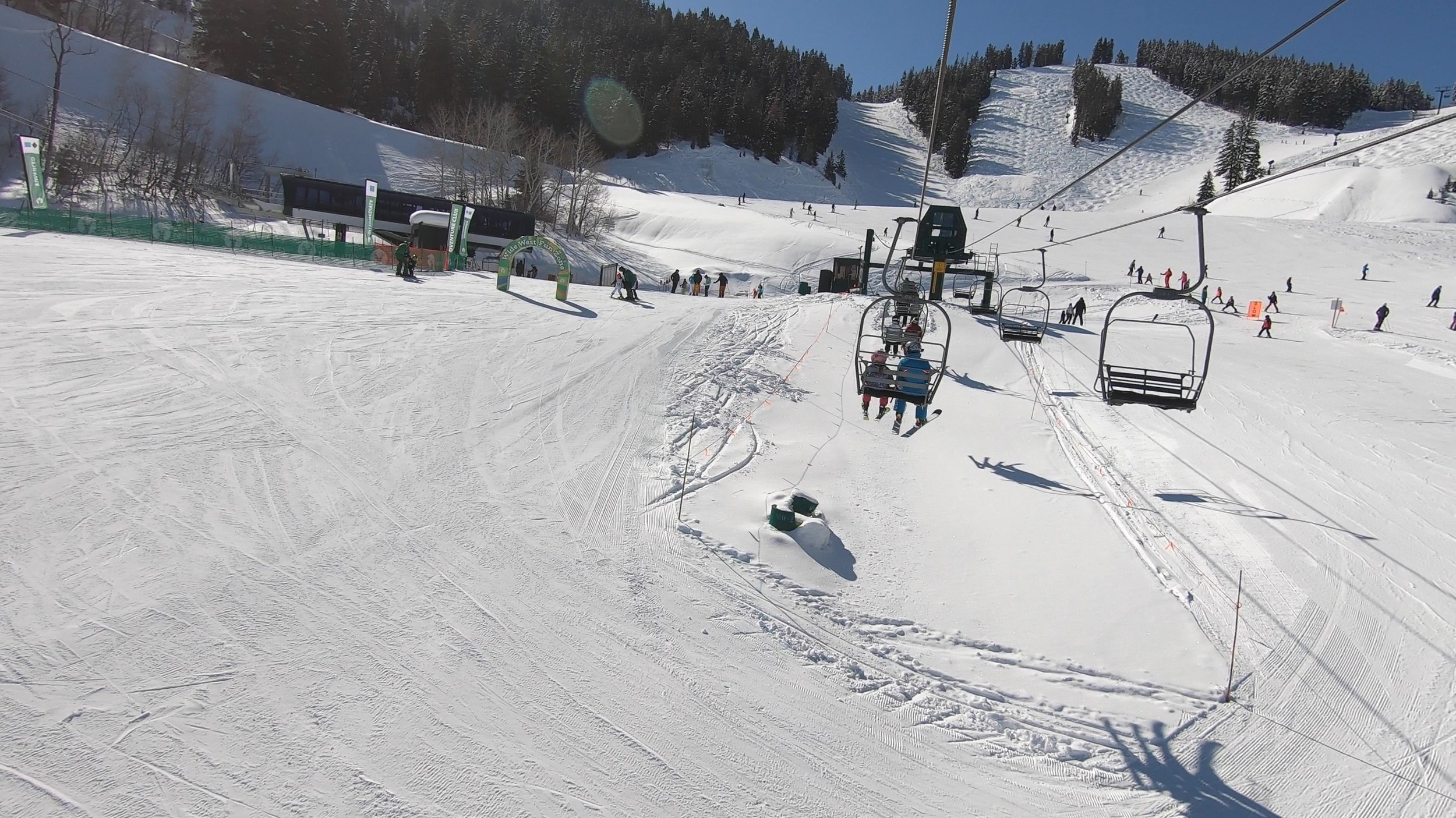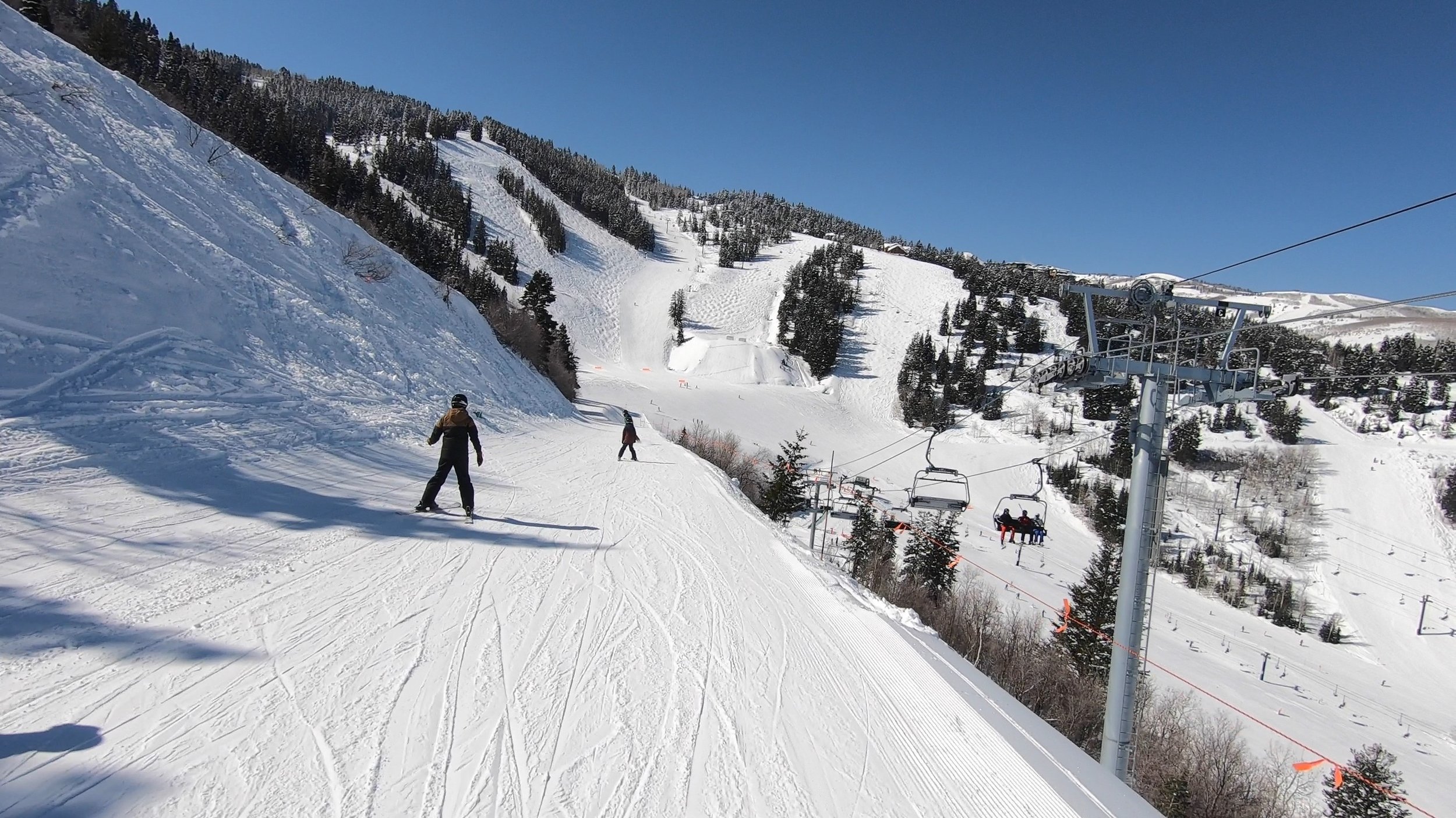Deer Valley Burns Express: The Most Head-Scratching Lift Investment of the Year
The entire Deer Valley Burns Express lift line, with the sole trail it serves (Gnat’s Eye) seen immediately to its right.
Background
For the 2022-23 season, Utah’s Deer Valley installed the Burns Express lift, a new beginner-oriented high-speed quad. With just 4 towers and a 90-second ride time, this chair is one of the shortest detachable lifts in North America. This high-tech lift has padded, multi-colored seats and auto-locking safety bars.
The Burns lift serves a small portion of the Gnat’s Eye trail, and is intended to function as a progression lift from the Wide West bunny hill, which is located directly below its base. The lift indirectly replaces the old Burns double chair, which previously ran along the full length of the bunny hill before being removed this summer; the still-in-place Snowflake chair, which previously only served the upper two-thirds of the bunny hill, has now been extended to serve the full bunny hill—and now effectively serves the same purpose as the old Burns lift.
We recently had the chance to visit Deer Valley and check out the Burns lift as it exists today. Here are our thoughts on the newly-upgraded setup.
A closeup of this season’s lift changes on Deer Valley’s trail map. The new Burns lift is highlighted in red, while the path of the old Burns lift is shown via the dotted red line. The Snowflake lift is highlighted in orange, with the lift extension shown via the dark orange dotted line.
The Experience
The goal of the Deer Valley Burns Express lift makes sense—it’s designed to provide an upgraded beginner experience for those learning but not truly new to skiing (but not snowboarding, as Deer Valley prohibits the sport on their property). However, as constructed, the lift project raises more questions than it answers.
First off, the Burns lift is really unintuitively placed. The chair starts at the top of the bunny hill rather than the base, meaning there’s no good way to get there. The only real option from the main base is to take the Snowflake bunny hill lift, which is low capacity and not designed to be a connector chair. Guests can technically choose to ride the Carpenter Express lift to reach Burns, but that lift extends all the way to mid-mountain, making it indirect, and doesn’t serve any green trails. The Burns lift doesn’t end in that useful of an area either, really only providing lappable access to a short portion of one beginner trail.
In order to reach the Burns Express, Deer Valley visitors must first either ride the low-capacity Snowflake lift or take a circuitous route with no green trails to mid-mountain.
There are a few tangible benefits to the new Burns lift. The chair offers access to the Mountaineer lift on Little Baldy Peak, which finally allows guests coming from the main base to get to Little Baldy without taking a blue run. In addition, taking Burns to Mountaineer is much more direct than the circuitous mid-mountain journey previously required to get to the top of Little Baldy. That said, since those coming from the main base need to ride the Snowflake lift first, this “shortcut” isn’t very desirable.
Due to its arrangement, the Burns lift sees little traffic. But even with just moderate crowds, experience problems start to manifest. The Gnat’s Eye trail is part of the only beginner route from Little Baldy Peak to the main base, and there’s no green-rated bypass to avoid the section of the trail that the Burns lift serves. This makes the Burns part of the run prone to significant congestion during even modestly busy times, with both all the Burns riders and all the beginners coming from Mountaineer funneling into the same place. This can be unnerving for beginners coming down from Mountaineer, who may find themselves suddenly coming across a significant increase in skier traffic.
The section of the Gnat’s Eye run that the Burns lift serves is quite narrow for a green trail.
So ultimately, the Burns Express presents a “damned if you do, damned if you don’t” setup. The goal of providing an expanded beginner footprint makes sense, but the lift’s setup is so unintuitive that nobody (except ski school) uses it. And even if use does pick up, the singular trail it serves is too cramped to provide an enjoyable experience.
Given how expensive a fancy detachable lift like this was (the Storm Skiing Journal quoted a price tag of $6 million), it feels like they should have spent the money on something more useful. The resort still lacks a lift that extends from base to the top of Little Baldy Peak, and even if the new Burns lift had risen in that arrangement, it still would have offered lappable access to beginner-rated terrain while providing a much more practical link.
Considering a ski trip to Deer Valley this year? Check out our full Utah rankings, as well as our comprehensive Deer Valley review from the 2021-22 season (a refreshed 2022-23 review will be out in a few months). You can also check out our thoughts on North America’s major 2021-22 ski resort lift and terrain upgrades in video form below.




